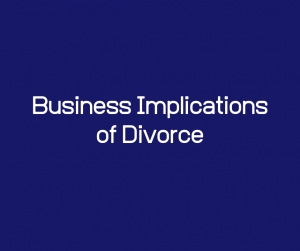Business Relationships in Times of Crisis
These challenging times present particular challenges to small business. Notwithstanding efforts to stimulate the economy, the fact remains that many businesses simply can’t function at a sustainable level without open doors and customers who require inventory, raw materials or products to sell. Empirical data supports a substantial downturn in gross domestic production such that the federal government has declined to publish economic forecast data for the summer of 2020. Millions have been separated from employment – either temporarily or permanently. Every business and every businessperson has felt the economic effect of the pandemic.
While small business may never be the same, it is not dead. We all know the United States economy is driven by small to medium employers no matter the media focus on big industry. There will no doubt be consolidation in nearly every sector of the economy from construction to retail. History has proven that, for the savvy businessperson, trying times like these bring opportunity. Taking advantage of opportunity requires strong, focused and forward thinking business relationships.
Business Implications of Divorce
When a business owner gets divorced, the business is often the major asset subject to distribution. Accordingly, the business and its’ ongoing operations are almost always implicated in the divorce. In most cases that I see, the business is a small business with one owner or a few owners. In the best case scenario, the business owners have planned in advance for situations that arise in a divorce through a Shareholders Agreement, Prenuptial Agreements and/or Postnuptial Agreements. Hopefully, the parties’ respective family law and business law attorneys can work together to best protect the business owner to ensure as smooth a transition as possible. Hopefully, the relevant agreements have set forth a valuation formula which can be upheld at law for purposes of the divorce. Counsel can also work together to insure that income is clearly defined and reported so that support is less contentious. Additionally, advance planning can be used to address the below issues so that a divorce does not mean the end to the business. While advance planning is not a guarantee, it will provide additional protections to the business owner.
A divorce can impact internal and external business relationships, support (between spouses and child support), equitable distribution (division of marital property) and business control. In terms of business relationships, banking relationships can come into play, especially if the spouse is a personal guarantee of the loan. It is often not easy or possible to have the spouse removed from the guarantee. The spouse may also have a role in the business and it may not be feasible for them to remain involved. For example, in cases where the spouse is client facing, a delicate balance will be necessary to transition the spouse out of the business without negatively impacting the business. This can be a challenge if the divorce is acrimonious. Finally, the roles of the parties within the business may create sustainability issues going forward. In some cases, one spouse has a particular talent (i.e. software development, marketing creativity or scientific knowledge) which cannot be easily replaced and without which the business may not be able to survive. Such issues impact valuation but also succession and strategy on distribution of assets.
As for support, when a business owner is a party to a support action, whether for support for a spouse or for a child, calculating income can be challenging. The definition of income for purposes of determining support is very broad and is not the same as taxable income. There can be practical issues in obtaining information and documents which reflect the income. Legal issues can also arise, such as whether income is being reported or if the court can compel income or retained earnings to be distributed from the business to the owner to pay support.
In equitable distribution, the business must be valued so that division of the assets can occur. Business control also comes into play. It is unusual for parties to retain joint ownership or for the non-business owner spouse to receive shares of the business so creativity and/or structured payments are often necessary unless there is enough cash reserved for an outright payment. The payout can cause a financial strain for the business.
To best protect a business in the event of a divorce of the business owner, it is advisable for business owners to have advance planning through the mechanisms listed above. While not a guarantee, it will place the business owner spouse in a much better position than ignoring these issues all together.
From a Litigator's Desk: Sometimes the best thing to do is… nothing.
It’s the hardest advice to give; do nothing. As lawyers, we envision ourselves as problem solvers. It’s our job to take on a client’s problem, real or perceived, and seek to find a solution. We listen, we evaluate, we plan. We apply our knowledge of the law, our experience and our judgment to develop a strategy to best address our clients’ concerns and maximize potential outcomes. We are often type “A” personalities. We are drawn to action.
So it makes sense that the hardest advice for a lawyer to give is to do nothing; to maintain the status quo, to grin and bear it, to forego that argument or claim. Sometimes, however, to do nothing is exactly what a situation requires.
For example, consider the small business with two equal owners both of whom are “involved” but to differing degrees. Each invariably believes the success of the business is primarily the result of their effort as opposed to the efforts of their co-owner. Should they separate? Dissolve the business? Sometimes the answer is certainly yes, but just as often the answer is no. The cost of the dispute, not only in terms of money spent but also revenue and opportunity lost, must be considered. It may even be that the co-owners’ combined respective skills are what drove the success of the business and that combination may be lost forever. Business factors such as proprietary trade secrets or exclusive trade agreements may render separation for value impossible. There is rarely a quick resolution to a business control dispute.
Similarly, when considering litigation, a party must consider whether litigation is actually in their best interest and not an emotional reaction. Whether claimant or defendant, the economics of litigation, success or failure, must be considered. Sometimes, however, the litigation economics form only part of the story. A business owner must also consider the business management distraction that litigation may cause, disharmony or disunity in the work force as employees and management personnel take up sides, or even the impact on customers and clients. A further concern is the question of how that portion of the public which becomes aware of the dispute - or even which must become aware of that dispute for business reasons – might perceive the respective positions of the parties. In some cases, litigation may force clients and customers to become concerned for their own business, thus creating significant stress on the relationship.
Tax reporting obligations are another area ripe with conflict. Often times an analysis of a business control dispute or damages evaluation in litigation will involve analysis of financial and tax reporting. A party must consider whether tax and financial reporting is consistent and that the facts as reported substantiate the position espoused by the party. In the litigation process, we often encounter all manner of tax financial recordkeeping and reporting issues; inaccurately reported income, misdirected payments, mischaracterized expenses and inventory value manipulation just to name a few. The parties to any dispute must consider the implications of public disclosure and avoid “taxicide”.
Many business relationships disintegrate to the point where continued co-existence is untenable and intolerable. In many cases, there are legal mechanisms that can be brought to bear to induce a change. A business owner is wise to consult with experienced professionals so as to evaluate the broad ranging ramifications of a particular strategy before embarking on what could be a dangerous or damaging path. Sometimes it is best to do…nothing.
From a Litigator’s Desk: Minority Business Ownership – Know Your Limits
Many an article or blog post concerns minority shareholder rights, shareholder oppression or shareholder “freeze out”. As business and litigation lawyers, we are always mindful of the rights between and among business owners, what can and cannot be done in furtherance of those rights and the legal mechanisms applicable to the exercise of those rights. We frequently write on the strategies available to a minority shareholder such as examination of books and records, claims of breach of fiduciary duty and the potential for appointment of a corporate receiver or custodian.
This is not that article.
The fact is, being a minority shareholder means that, by definition, there are often things you simply cannot control. A shareholder or member in a business entity who possesses less than a controlling stake must have reasonable expectations as to the rights attendant to such ownership and understand the limits of such rights so as to make informed decisions concerning the investment of time, energy and money in pursuit of the collective enterprise.
Let’s start with who owns the remaining shares in the company. In the absence of an agreement to the contrary, the majority shareholder is free to transfer the majority (said another way; controlling) interest in the company without the consent of the minority. A transaction can result in a change in control such that the minority shareholder suddenly works for someone entirely new. While a minority shareholder can enjoy “dissenter’s rights”, such rights are applicable in very narrow situations specified by statute. In fact, in the absence of a prohibition, the stock in a business entity is readily transferrable, just like on an exchange, if a buyer and/or seller can be identified.
Internally, a minority shareholder can find it difficult to impact the direction of the business. Depending on the by-laws of the entity and, frankly, the will of the majority, a minority shareholder may or may not have a voice on the board of directors and thus may not possess a vote on material decisions such as the persons who will fulfill critical roles in the executive branch of the business such as the officers of the corporation. More importantly, a minority shareholder may not have input on the financial operations of the company including distributions, financing arrangements, major purchases of inventory, equipment or talent. All of which can dramatically affect the annual bottom line.
Even employment is not guaranteed to a minority in interest. In the absence of an agreement to the contrary, the employment of a minority shareholder may simply be at will in the same way as the sales force, the administrative assistants or the custodian. Certainly, terminating a minority’s employment could be one of the factors argued in a freeze out, but in the absence of other factors, termination of employment alone may not give rise to a cause of action. Certain courts have suggested continued employment may be implicit in a “founder” but those situations are few and far between and a plaintiff/minority shareholder must be prepared with more to argue than the end of employment if freeze out is alleged.
In business, like politics, being in the minority means sometimes you are powerless to immediately change the course of the company. Sometimes, a group of shareholders can band together to pool their collective influence for their mutual benefit. Other times, the best strategy is to become the majority even when the acquisition of additional shares comes at an unnecessary or unanticipated cost. Under any circumstances, rights afforded to the majority are not constrained solely because a minority shareholder does not agree with a particular course of action.
As a litigator, I am often contacted by minority shareholders who are frustrated by their lack of control or influence. While the law offers certain protection for holders of such minority interests, those remedies are factually limited and are often unsatisfactory even if granted in full after significant expense in litigation. Certainly an appropriate agreement outlining the respective rights and obligations can change the analysis. Business owners should consider, and plan for, what rights their stake in the company provides.
From a Litigators Desk: Managing a Non-Performing “Partner”
Thousands of businesses across the United States fall within the definition of what is commonly referred to as “small business”. Many of these small business are formed by two “friends” with compatible skill sets and both possessing knowledge of a particular industry. Business owners commonly refer to their co-owners as “partners”. As the business and its’ complexity grows, deficiencies in performance or capacity on the part of one partner may be exposed. Alternatively, the absence of immediate success can cause a less patient partner to seek other opportunities and abandon the work that is necessary for the collective good. What starts as a promising partnership can quickly turn sour. Here are a few tips on moving forward:
1. Agree on material issues ahead of time. It goes without saying that a written agreement which contemplates and addresses material issues benefits everyone. Terms frequently addressed in such agreements include the relative duties of the parties, corporate officers, duties of directors and financial matters. If shareholders/partners/members are required to devote substantially all of their time to the venture, the agreement must so state. Similarly, if shareholders/partners/members can be required to contribute capital to the business, the prevailing agreement must so state. Agreed upon rights and remedies upon abandonment of functions within the business by a shareholder/partner/member can provide the road map for resolution and expedite transition.
2. Change terms of employment. An option which may be available to a shareholder/partner/member is the exercise of corporate power to change terms of employment with respect to the non-performing shareholder/partner/member. While a founding shareholder/partner/member may arguably have certain rights to continued employment, such guarantees are limited and may not preclude a change in terms when faced with non-performance or abandonment. Exercise of corporate power does not come without risk and any change in employment terms is almost always alleged as part of a minority shareholder oppression claim.
3. Offer a buy-out. Certainly the cleanest and most efficient means to end an unproductive arrangement quickly is to acquire the non-performing shareholder/partner/member’s interest in the business by the payment of money. Of course, such an agreement is not always financially available. Moreover, a voluntary transfer necessarily implicates that that non-performing shareholder/partner/member agree. Issues of valuation, income streams, indemnification and restrictions against competition can complicate any potential buy-out.
4. Sell the business. Often the solution to a disagreement on partner performance is a sale of the business with a corresponding post sale employment agreement for the performing shareholder/partner/member. Money is a powerful motivator. A sale generates money in a lump sum which can induce a shareholder/partner/member to forego the ongoing income stream that results from future operations. Certainly, control over the sale process, including the legal right to effectuate a sale by virtue of agreement or corporate control, are essential factors for evaluation.
5. Dissolve and start something new. As a matter of last resort, dissolution of the entity may be the only way to gain freedom from a non-performing shareholder/partner/member. The Business Corporations Law provides a mechanism for dissolution. Provided the requirements can be met, a shareholders/partners/member may seek judicial dissolution of the entity essentially forcing a judicial sale. An important aspect of dissolution is relief from fiduciary duties owed to the business and minority owners. Dissolution can be a complicated and expensive proposition and very disruptive to ongoing business operations but remains a viable strategy when business owners can no longer work together but also cannot agree on separation.
From a Litigator's Desk: Keep Your Business Laundry In-house
Business partnerships are like marriages; sometimes they work great from the start and before you know it you are celebrating a 25 year anniversary with a big party with all of your clients and customers in attendance. And sometimes; not so much. For reasons unique to business relationships and the personalities involved, business partners sometimes find they can no longer function together, no longer share the same vision, and can no longer tolerate sharing the responsibilities or benefits of common ownership. We refer to the painful and expensive process of separation as “business divorce”.
As in any divorce, emotions run high. The natural instinct is to assess blame and recruit those close to the business to one “side” or the other. Such recruiting efforts implicate disclosure of sensitive, often damaging information with the idea that inflicting pain will induce a desired course of conduct. Rarely is such an ill-conceived plan rewarded with success.
The reality is that preservation of the business as an asset should be the primary concern. Often that means preserving the opportunity for the business venture to continue operations without interruption, modification or additional added pressures attendant to disharmony. Whether the business can be divided according to an acceptable plan among the shareholders, sold as a going concern, or liquidated in an orderly fashion, continued successful operations are essential to return on the shareholders’ investment.
Successful operations are a function of several factors. First and foremost, management, employees, contractors and staff must be confident in the direction of the entity. Public disclosure of disputes among ownership breeds workforce instability, discontent, mass departure and potential competition on the part of key employees with the capacity to do so.
Customer relationships must also be protected. Instability will most certainly cause a client to search for an alternative provider of the same product or service. A client will not risk their own business by not addressing the potential impacts of instability in yours.
The bank can become concerned as well. Lending relationships are complicated. Often businesses obtain term loans or lines of credit which must be “rested” (reduced to zero) from time to time. A borrower’s options upon maturity can be limited and, notwithstanding a long and happy banking relationship, the bank may not be required to extend credit on the same terms and conditions. The bank may even take the position, under certain circumstances and certain loan agreements that the bank is insecure as a result of dissention thus forcing very difficult financial decisions.
Finally, in all likelihood, public disclosure of internal disputes results in the parties becoming entrenched in their respective positions such that a future together is impossible. Even a sale under such circumstances is likely to net less than market as a buyer is quick to assert pressure on one shareholder or the other in an effort to negotiate the best deal.
Really no good can come of a public airing or an internal dispute. Just like a married couple should not publicize their grievances on Facebook, business owners should take care to keep their disputes in house while seeking resolution through any number of mechanisms – at least until it becomes apparent that such resolution is not possible. Even then, the minimum amount of information necessary to effectuate a course of conduct should be disclosed in the least applicable public way.
From a Litigator’s Desk: Key Questions to Consider in Commercial Litigation
People often ask, “What kind of lawyer are you?” After my stock (and feeble) comedic response of “a good one”, I often say I am a “commercial litigator”. I explain that our practice includes litigation of disputes which arise between businesses and business owners. Commercial litigation includes a wide range of potential issues ranging from business torts to breach of contract, both internal to a business entity, and between two or more separate entities. While there are a wide range of potential issues which must be considered, there are certain basic tenets which I always discuss with our clients before recommending litigation or taking on their representation.
First, do you have an agreement which might apply to the situation and, if so, what does that agreement say about your position? Agreements can come is various shapes and sizes, such as corporate by-laws, a formal shareholder agreement, a proposal combined with an acceptance or performance, or even a simple exchange of emails. Documentary evidence is key, as a litigator is challenged to explain why the written word should not be impactful.
Second, what is your goal? The kiss of death as to our representation is a client who says “it’s not about the money, it’s the principle”. When I was a young lawyer I had a mentor who gave sage advice when he communicated the firm’s policy that litigation was only appropriate when money was involved. He would politely say, “we don’t litigate over principle”. In many ways and in most situations that adage applies. However, in the corporate setting, sometimes the connection to money is not readily evident or direct such as with regard to disputes over corporate control or enforcing a covenant not to compete. In many situations, I caution stakeholders to take the long view and weigh the probable outcomes from a purely practical standpoint, taking care never to lose sight of their long range business goals.
Third, what is your capacity for litigation and business distraction? Litigation not only costs money in terms of attorney fees, accountant fees, experts and costs, but participation also requires commitment of a leader’s most valuable commodity; time. Business people are first and foremost concerned with business (daily operations, management and the bottom line). Litigation invariably requires substantial client involvement in developing strategy, reviewing pleadings, searching for documents, reviewing documents produced by other parties and preparation for testimony. I advise potential parties to litigation to think long and hard about the cost/benefit to the business of such an undertaking.
Fourth, what can you hope to recover or save; and what will it cost to do so? While a corollary to litigation about money, it is not the same question. The evaluation of potential cost is complex and issue dependent. In a recent case, settlement discussions in a commercial litigation setting were driven by the anticipated six figure cost to translate thousands of pages of information from Chinese characters to English. Costs of experts on any issue involving an opinion on issues ranging from the standard of care applicable to a corporate officer, to whether a machine functioned in the way represented, can rapidly accumulate. Unless there is a provision in an agreement which provides for the recovery of attorney fees or such recovery is otherwise permitted under law, those fees and costs are not recoverable.
The above is not to discourage litigation of bona fide disputes; of which we handle many. It is simply imperative that the lawyer and the client be on the same page as to expectations, risks and litigation management. These questions can assist in forming the framework of a solid attorney client relationship in a commercial litigation setting, which goes a long way toward developing realistic expectations, reducing the stress inherent in the process, and optimizing the chances of a successful outcome.
Joint Business Ownership: Unwinding Those Relationships Can Be Complicated and Costly
It is not unusual for business owners such as manufacturers and their suppliers and consultants to enter into joint ownership in the pursuit of mutual business goals. Those pursuing this strategy should consider that such entanglements can lead to costly future litigation should circumstances change and interests of the parties diverge. In a recent case, a dispute arose between owners of a custom manufacturing limited liability company in which AMM’s client (and a supplier to that same LLC) possessed 33 1/3% of the issued and outstanding ownership interests. The firm’s client also owned 100% of the stock in a separate business entity which supplied materials to the jointly owned custom manufacturer.
When the owners had a falling out, an issue arose with regard to the payment of outstanding invoices generated by the supplier for materials provided to the jointly owned custom manufacturer. When a resolution could not be reached, AMM, on behalf of the supplier, commenced litigation. During the litigation, the majority member of the jointly held custom manufacturer transferred all of the inventory and other assets to a newly formed entity, owned entirely by him, without the payment of consideration, that is to say, without compensating the supplier entity. The transfer of assets left the jointly held entity with insufficient assets to meet its’ liabilities; including the liabilities to the supplier. As a matter of strategy, the controlling member of the jointly owned entity allowed default judgment in favor of the supplier and against the jointly held custom manufacturer. The newly created entity went about doing business utilizing the inventory transferred without regard to the liability to the supplier.
The transfers gave rise to new and additional claims under the recently adopted Uniform Fraudulent Conveyances Act and claims of breach of fiduciary duty; all of which had to be litigated while the newly formed company operated a separate business. Clearly, a small business owner can no longer simply set up shop as a new entity when things go bad and debt accumulates. However, the complexity of ownership structure and relationship between the various entities made judicial intervention very difficult. In the end, the newly formed entity was forced to file a general assignment for the benefit of creditors; the majority owner lost his interest in all of the respective entities and eventually filed for personal bankruptcy.
The above is just one of many “war stories” encountered in attempting to unwind jointly owned business enterprises. Business owners and potential investors should think very carefully before engaging in shared ownership. What may seem like a mutually beneficial relationship at the outset can be costly and challenging to undo if things go bad in the future.
The take away for business owners and potential investors is to think very carefully before engaging in shared ownership. What may seem like a mutually beneficial relationship at the outset can be costly and challenging to undo if things go bad in the future.
Factors to Consider When Shareholders No Longer Agree
By Thomas P. Donnelly, Esquire
Reprinted with permission from the November 23, 2015 issue of The Legal Intelligencer. (c) 2015 ALM Media Properties. Further duplication without permission is prohibited.
A high business “tide” does not necessarily float all boats. Often, when business is good and profits increasing, a business owner’s desire to avoid sharing those increasing profits with an underperforming partner can create an irreconcilable divide; particularly in the case of a partner not intimately involved in the day to day operations of the business. Similarly, more difficult economic times stress cash flow, and may motivate a performing partner to explore options to decrease or eliminate that portion of the business income flowing to those performing at a lower level. Of course, the lesser performing partner generally adopts a contrary perspective. In either case, the divergence between two or more partners can render the status quo unacceptable and threaten the business as a going concern.
In approaching disputes among shareholders several factors must be considered. First, does the attorney represent the company, the majority interest, or the minority interest? The practitioner’s potential strategies must be informed by the relative position of the parties. Second, what are the respective goals of the parties? Certainly, the long term goal of extracting the most gain in income or the value of the investment is the goal of all the parties, but short terms strategies can have a dramatic and sometimes unintended consequence. Third, what is the impact of the potential short term strategies, not only on the business, but also on the individuals? Financing arrangements and personal guarantees must be considered. Finally, the respective rights and obligations of the shareholders post dissolution must guide the process.
When approached by a client considering business divorce, the attorney must consider potential conflicts of interest. Often, the majority owner’s first call is to corporate counsel. However, Rules of Professional Conduct 1.7, 1.8 and 1.9 bear upon whether corporate counsel can represent the interests of only one shareholder/member. In summary, representation of the “company” in the same or substantially related matter, or receipt of confidential information which may bear upon the representation of the party not seeking to be represented by corporate counsel, would preclude corporate counsel from undertaking the representation of a single shareholder/member. In some circumstances, it may be appropriate for the company to have separate counsel, such as where the company is a potential defendant in litigation commenced by either a third party or a shareholder. However, such representation is complicated by divergence among board members and can present difficult issues in corporate governance and communication between counsel and the corporate client.
Representation of the majority interest provides for the implementation of whatever remedies may be available under the terms of written agreements among the shareholders or by means of corporate action as to a non-performer. Significantly, there is no statutory right or method for the involuntary removal of a shareholder (arguably, such a remedy may be available in a partnership or Limited Liability Company setting). Potential courses of action include severance of employment or reduction in employment benefits for the non-performer, voluntary dissolution if provided and appropriate pursuant to the agreements between the parties, and modification of corporate governance. Of course, such potential courses of action do not come without risk, and the potential for litigation alleging minority oppression should be anticipated. In such a case, documentation of non-performance and job duties is compelling.
Representation of the minority owner is more difficult. Many times, the minority owner is left with litigation alternatives such as actions for the appointment of a custodian or liquidating receiver pursuant to 15 Pa.C.S.A. Sections 1767 or 1985, respectively. While these litigation remedies can be compelling, it should not be expected that litigation would result in continuation of the status quo indefinitely. Litigation rarely restores a broken relationship. Further, as recently noted by the United States District Court in Spina v. Refrigeration Service and Engineering, Inc. 2014 WL 4632427, a shareholder seeking the appointment of a receiver or a custodian bears a heavy burden and such appointment is at the discretion of the Court.
In addition, litigation alternatives necessarily incorporate business risk. Can the company survive the appointment of a custodian? By definition, a custodian is designed to continue the business as opposed to liquidation. The impact of a custodian on customer relationships, the entity’s capacity to contract and the willingness of business partners to engage in long term planning or projects may render liquidation inevitable. Certainly, the appointment of a custodian or receiver results in a loss of control on the part of the shareholders. All policy and management decisions fall within the purview of the court appointee. Such loss of control can be particularly problematic as it pertains to the case of tax reporting.
That same loss of control must be considered in a liquidation scenario. Liquidation contemplates an orderly winding down and distribution of assets which should be anticipated to include intellectual property and customer lists in addition to any fixed or hard assets possessed by the entity. As noted in Spina, liquidation is generally carried out by public auction so as to ensure fairness among shareholders. In the event of a liquidating receiver, a marketing campaign designed to enhance the value of the assets and maximize the selling price should be anticipated. In such circumstance, neither party may be in a position to acquire the liquidated assets or may be forced to over-pay, thereby rendering such acquisition economically unfeasible. Accordingly, while the goal at the outset of a liquidation proceeding may be to force a buy out of a shareholder, the end result may be that no party is in a position to acquire assets and engage in continued business operations.
The impact of a custodian or receivership on the individual business owners must also be considered. Business owners frequently guaranty corporate debt. The commencement of an action for the appointment of a custodian or receiver is almost always defined as an event of default with regard to the entity’s financing arrangements and could also trigger liability under the personal guaranty.
Finally, post liquidation obligations, or the lack thereof, should also be considered. It should be anticipated that former partners would compete post liquidation. The liquidation of the entity by definition precludes any claim for breach of fiduciary duty on the part of the company to the extent based on post liquidation acts or omissions and any right to enforce a post termination of employment restriction against competition. However, arguably, the sale of the entity’s assets, including confidential information such as customer lists, may implicate the Uniform Trade Secrets Act and preclude use of information known to the shareholders in competition with the buyer. While no case decided under Pennsylvania law addresses the application of the Act to such circumstance, the Act appears to be applicable where a shareholder retains possession of information which was subject to transfer in liquidation.
The complexities of business divorce through litigation mandate that the parties consider and pursue all avenues of amicable dissolution and consider all proposals for voluntary consolidation of ownership before pursuing litigation with uncertain results.
Tom Donnelly is a Partner with Antheil, Maslow & MacMinn. His practice focuses primarily on commercial litigation and transactions, employment disputes and personal injury.
Look Before You Leap Into That Business Relationship
Business divorce, just like traditional matrimonial divorce, can occur for many reasons. Many times, business divorce is occasioned by underperformance and the need to separate an underperforming owner. However, the opposite circumstance, a business that has done well, can also spur desire for change in structure. Just like matrimonial divorce, business divorce can be a long, painful and expensive proposition. Consideration of trigger events for dissolution and setting an exit strategy before commencing the business venture can manage the expectations of the parties and facilitate transition when it becomes necessary. And it almost always does.
One of the primary considerations is trust. Consider the level of trust you place in a business partner on so many levels. Trust ranges from the basics of whether you can trust your partner not to have a hand in the cookie jar, to more esoteric questions of whether you can trust your partner to share your long term vision. All too often clients come to us with stories of unexplained payments for personal expenses which are only discovered by accident. What are the rights and obligations of the company and the business partners in such event? These rights should be spelled out in the agreement between the parties, otherwise the company, and the innocent shareholders, are left to argue common law claims and may be without a way to specifically extract the untrustworthy owner.
Trust goes deeper than the simple situation of defalcation (misuse of funds). Can you trust your business partner to have the same desire to grow your business and increase sales and performance metrics over an extended time? Business entities generally have perpetual existence. Can you trust that your partner will continue to make the requisite investments of time, energy and money that are necessary to bring the success you work so hard to achieve? If the agreements between the parties do not provide for a mechanism to remove that partner, or at least monetarily induce that partner to voluntarily separate, what strategy is available to accomplish the necessary change?
If extraction of a non performing owner is one side of the coin, the terms of voluntary separation are the other. Even in the absence of material differences between owners and managers, time and circumstance often require parties to go their separate ways. The terms of voluntary separation can be every bit as complex as forcible removal. Often, the most problematic inquiry is the right to be compensated in consideration of separation. Such terms of separation can vary based on valuation methodologies such as “market” or “book” values, timing of payments, reductions or additions to value based on subsequent conduct. In the absence of advance planning, the parties are almost certain to find dispute.
Post-employment obligations and fiduciary duties are also fertile ground for dispute. Corporate officers and directors have fiduciary obligations to the business. Partners, shareholders and members may have fiduciary obligations to each other. A departing shareholder may or may not be permitted to directly compete either during or after termination of the business relationship. Certainly, issues arise with respect to client/customer relationships and confidential information. More substantial issues may arise when the business develops a new technology or intellectual property which one party seeks to exploit in a different way. Agreements between the parties can address such possibilities and preserve rights by contract which might otherwise be ambiguous.
What if it all goes wrong? Again, business entities are generally established to have a perpetual existence, so termination must be accomplished by agreement or statutory procedure. What kind of consent is necessary to effectuate dissolution? Must all of the shareholders or members agree? Agreements can specify events and effect of dissolution including specific assignments in distribution of assets according to differing methodologies or factual circumstances. In circumstances where one party is opposed to liquidation or dissolution, the situation can become even more complex. Occasionally, only the appointment of a receiver can effectuate liquidation or dissolution; a generally unappealing circumstance as such an appointment necessitates the loss of control.
The questions posed and circumstances described above underline the importance of careful consideration prior to establishment of business entities. Such considerations during the business “engagement” and before business matrimony are necessary to prevent significant hardship when expectations are not managed. Advance planning though counsel can address many of the issues potentially faced by business owners and help the parties realize their expectations when circumstances change.





























